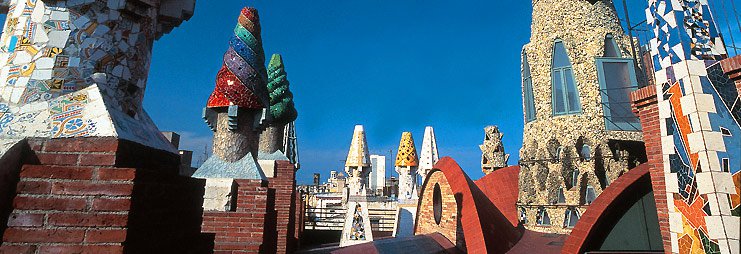 |
Antoni Gaudi
source: http://0.tqn.com/d/architecture/1/0/h/7/1/gaudi-bw.jpg
|
One of my favorite architects in the Art Noueveau period and overall is Antoni Gaudi. Born in 1852 in a small town called Reus, just south of Barcelona, and he died in a street accident in 1926. At age 16, Gaudi left Reus to go to Barcelona. Soon after, he began to take studies in the school of Architecture of Barcelona. In 1878, he opened his own office and began his professional career as an architect. Mauresque, Gothic and Oriental architecture all influenced Gaudi’s style of architecture. In addition to those styles of architecture, the human body, plants, and animals also heavily influenced Gaudi’s style. He was a good friend of count Güell, an entrepreneur, who made him real Viollet le Duc’s ‘Entretients sur l’architecture’, which heavily influenced him and ultimately added to his love and respect to the Art Nouveau movement. This caused him to break away form imitating old styles of architecture like most architects were doing at the time and form his free and organic style of architecture. His uniqueness and his choice to break away from what everyone else was doing at the time sets him apart from most architects of that period. It is safe to say he created a new genre of architecture.
Gaudí's work stretched the limits of architecture and exposed the freedoms within the art of architecture. His work expressed plasticity via the undulating lines, organic forms and shape, loose rhythms, and harmonies of colors, forms, and materials. These were expressed in architectural surfaces and sculpted features in his buildings.
CASA MILA
 |
Casa Mila. Barcelona, Spain
source: http://englishforarchitects.pbworks.com/f/1296146308/CASA_M~1.JPG
|
One of his most popular and criticized works of architecture is La Casa Mila, built from 1905-1910. It was a commercial building built for Roser Segimon and Pere Milà. The heavy and self-supporting façade is tied to the floors that lie behind it. The building plays with the idea of human anatomy, where the “bones” are the structural components and other decorations such as the balcony railings of the building and the “skin” is the organic, smooth concrete façade.
 |
Ornamental Chimneys atop Casa Mila
source: http://upload.wikimedia.org/wikipedia/commons/5/56/Casa_Mila_Rooftop.jpg
|
The clustered chimneys, balcony railings, and roof vaults, designed by Jujol, are also notable features of the building. The organic nature of this building forced Gaudi to defend his concept and why he chose to design the project with an organic concept.
PALAU GÜELL
 |
Palau Güell. Barcelona, Spain
source: http://lalibreriadechelo.files.wordpress.com/2012/05/palau-guell6.jpg
|
In 1885, count Güell commissioned Gaudi to design his private residence in Barcelona. This particular piece of architecture had to be bold because Güell had to show off his wealth to friend and acquaintances, since the place was going to be used for exhibitions, concerts, and other events. Gaudi used traditional building techniques, but modified with his boldness. He used a variety of materials and put more emphasis on some materials verses others. The building itself also became a “rags to riches” metaphor. The bottom of the façade started off somewhat traditional with the parabolic arches, columns and modular marble siding, but begins to intensify with the 2nd second story extruding out from the façade with the series of close apertures framed with decorated iron.
 |
Ornamental Chimneys atop Paula Güell
source: http://qrplaces.it/QRImages/Posto/50B97ACE-E177-2612-D099-BF345BB336C2/palau_guell_20110708_1305_5687.jpg
|
The masonry siding, reflecting medieval architecture, is topped off with these extremely ornamental chimneys, looting the roof with colors and forms that totally contrast with the rest of the building, but create harmony and visually holds the building together. Twenty of these sculptural chimneys, made of ceramic tile, stained glass, and marble line the roof and are symbols of count Güell and his wealth.
No other architect at this time was as bold as Gaudi was. He took ideas form nature, plants, animals, and human anatomy and united them with architecture. His boldness and uniqueness magnifies him as one of the most pivotal architects that influenced modern architecture. He broke down the barriers of design at the time, incorporated all of his natural and architectural inspirations, and took architecture to new levels and realms with his boldness.
Sources:
No comments:
Post a Comment